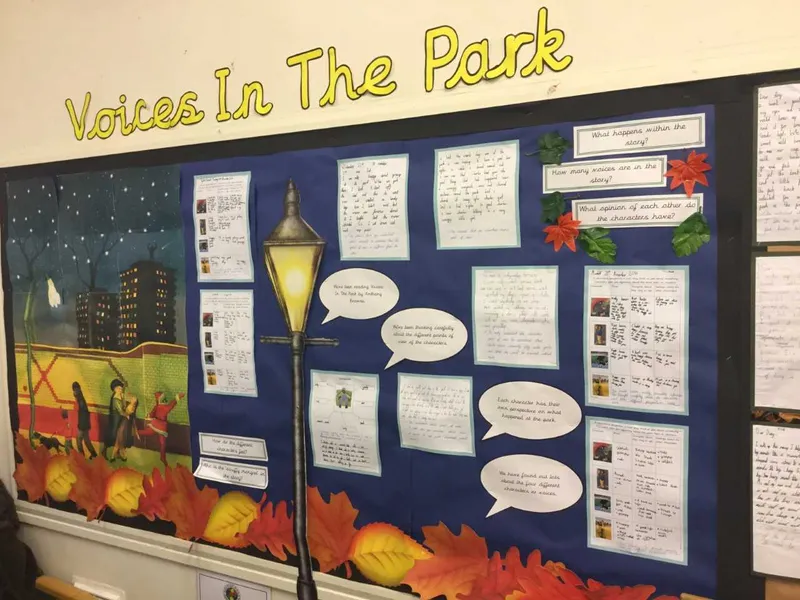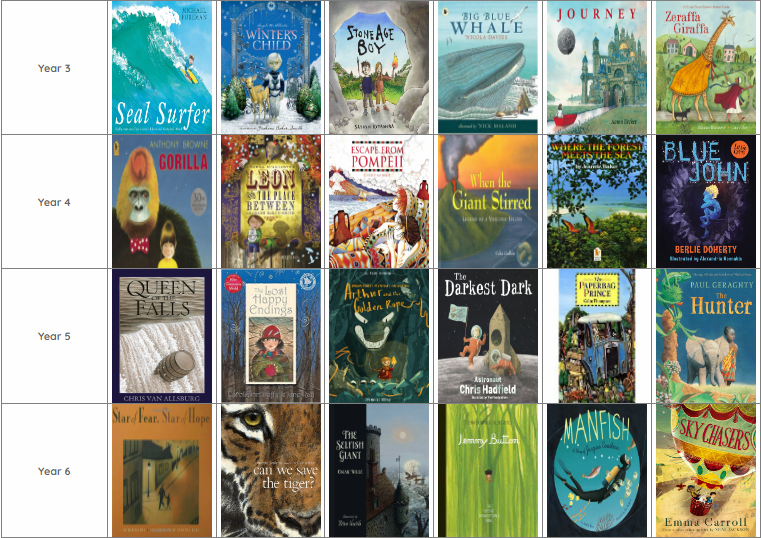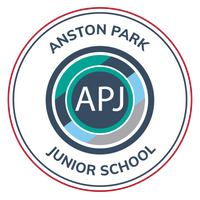English
Subject Leader: Mr French
English National Curriculum
Purpose of Study
- English has a pre-eminent place in education and in society. A high-quality education in English will teach pupils to speak and write fluently so that they can communicate their ideas and emotions to others and through their reading and listening, others can communicate with them.
- Through reading in particular, pupils have a chance to develop culturally, emotionally, intellectually, socially and spiritually. Literature, especially, plays a key role in such development. Reading also enables pupils both to acquire knowledge and to build on what they already know.
- All the skills of language are essential to participating fully as a member of society; pupils, therefore, who do not learn to speak, read and write fluently and confidently are effectively disenfranchised.
Aims
The National Curriculum for English aims to ensure that all pupils:
- read easily, fluently and with good understanding
- develop the habit of reading widely and often, for both pleasure and information
- acquire a wide vocabulary, an understanding of grammar and knowledge of linguistic conventions for reading, writing and spoken language
Appreciate our rich and varied literary heritage - write clearly, accurately and coherently, adapting their language and style in and for a range of contexts, purposes and audiences
- use discussion in order to learn; they should be able to elaborate and explain clearly their understanding and ideas
- are competent in the arts of speaking and listening, making formal presentations, demonstrating to others and participating in debate.
You can download the full National Curriculum for English by clicking the link below:
English Curriculum Intent
Our most up to date policies for writing, SPaG and reading are here:
Teachers plan learning opportunities around novels, animations, poems and experiences that will engage and encourage children. When teachers plan these learning experiences and opportunities they must ensure that children are being taught in line with the statutory National Curriculum and the school's English policies.





Writing
We follow a Mastery approach to English through the programme ‘Pathways to Write.’ Units of work are delivered using high quality texts and children in all year groups are given varied opportunities for writing. Skills are built up through repetition within the units, and children apply these skills in the writing activities provided. Many opportunities for widening children’s vocabulary are given through the Pathways to Write approach and this builds on the extensive work we do in school to provide our children with a rich and varied vocabulary.
Each unit covers a range of areas in the national curriculum:
- Mastery of vocabulary, grammar and punctuation skills
- Writing a range of genres across a year
- Vocabulary development
- Using a wider range of reading comprehension strategies as a whole class
- Spoken language activities including drama and presentations
- Opportunities for practising previously taught genres
- An extended, independent piece of writing
This process follows three stages:
The Gateway (1-2 lessons)
- Begin at the Gateway with a ‘hook’ session to intrigue and enthuse young writers
- Use objects, people, images or role-play to stimulate questions about the chosen text
- Give pupils the opportunity to predict the text
- Establish the purpose and audience of the writing
- Revisit previous mastery skills and ongoing skills
The Pathway (10 lessons)
- Introduce pupils to three new writing skills from their year group curriculum
- Provide opportunities to practise and apply the skill they have learnt through short and extended writing tasks including character descriptions, poetry, dialogue between characters, fact files or diary entries in role
- Provide opportunities to re-cap and apply previously taught skills
- Challenge greater depth writers through a wider range of tasks e.g. changes to form, viewpoint and audience
Writeaway (4 lessons)
- Section and sequence texts independently or collaboratively
- Create extended pieces of writing over time
- Opportunity to apply mastery skills
- Time for planning, writing, checking, editing, redrafting and publishing
- A fiction or non-fiction outcome will be written (covering a wide range of genres and themes over the year)
You will find the end of year expectations for writing, reading and spoken language for each of our year groups in the documents below. For further detail on the skills that your children are learning on a termly basis, please contact your class teacher.
| Name | Format | ||
|---|---|---|---|
| Files | |||
| Overview of objectives Y3 1.pdf | |||
| Overview of objectives Y4 1.pdf | |||
| Overview of objectives Y5 1.pdf | |||
| Overview of objectives Y6 1.pdf |
Our writing units are linked to a range of high quality texts. These texts act as a hook to encourage children to write for a range of purposes and audiences.

Pupils as writers develop skills in the following areas:
- transcription (spelling and handwriting)
- composition (articulating ideas and structuring them in speech and writing)
It is essential that teaching develops pupils’ competence in these 2 dimensions. In addition, pupils should be taught how to plan, revise and evaluate their writing. These aspects of writing have been incorporated into the programmes of study for composition.
Writing down ideas fluently depends on effective transcription: that is, on spelling quickly and accurately through knowing the relationship between sounds and letters (phonics) and understanding the morphology (word structure) and orthography (spelling structure) of words. Effective composition involves articulating and communicating ideas, and then organising them coherently for a reader. This requires clarity, awareness of the audience, purpose and context, and an increasingly wide knowledge of vocabulary and grammar. Writing also depends on fluent, legible and, eventually, speedy handwriting.


At Anston Park Junior School, we encourage children to see writing as a process. We teach children to follow the 'Think, Say, Write and Read' model to develop ideas before writing them down and to be reflective when reading their work back identifying and editing errors and making changes to their writing that improve their first draft. Children learn to write for a range of purposes.

If you are not sure about some of the grammar terminology used in school this glossary might be useful. Please click to download.
| Name | Format | ||
|---|---|---|---|
| Files | |||
| Parent glossary 1.pdf |
Spelling
Children work hard at Anston Park Junior School to be confident and accurate spellers. Being able to spell correctly presents a confident, knowledgeable front to the world. Children are taught spelling in line with the National Curriculum. In school, children engage in spelling sessions at least 3 times per week. Children learn about the etymology of words (where they come from) and morphology to deepen their understanding of both vocabulary and spelling.
We follow a mastery approach to the teaching of spelling through the programme ‘Pathways to Spell’. It is a programme designed to deliver the statutory content of the Primary National Curriculum for spelling in key stage 2. Through weekly teaching of spelling objectives and development of a whole school approach to word transcription, vocabulary development and proof-reading, the programme aims to develop children as proficient spellers.
You will find the end of year expectations for spelling for each of our year groups in the attached documents. For further detail on the skills that your children are learning on a weekly basis, please contact your class teacher.
| Name | Format | ||
|---|---|---|---|
| Files | |||
| Y3 and Y4 Spelling Objectives 1.pdf | |||
| Y5 and Y6 Spelling Objectives 2 1.pdf |
There are some words that children have to know by the end of year 4 and a collection of words that children have know by the end of year 6. These words are in your child's reading record. You can find these by clicking on the links:






Reading
The programmes of study for reading consist of 2 dimensions:
- word reading
- comprehension (both listening and reading)
It is essential that teaching focuses on developing pupils’ competence in both dimensions; different kinds of teaching are needed for each.
Skilled word reading involves both the speedy working out of the pronunciation of unfamiliar printed words (decoding) and the speedy recognition of familiar printed words. Underpinning both is the understanding that the letters on the page represent the sounds in spoken words. This is why phonics should be emphasised in the early teaching of reading to beginners (ie unskilled readers) when they start school.
Good comprehension draws from linguistic knowledge (in particular of vocabulary and grammar) and on knowledge of the world. Comprehension skills develop through pupils’ experience of high-quality discussion with the teacher, as well as from reading and discussing a range of stories, poems and non-fiction. All pupils must be encouraged to read widely across both fiction and non-fiction to develop their knowledge of themselves and the world they live in, to establish an appreciation and love of reading, and to gain knowledge across the curriculum. Reading widely and often increases pupils’ vocabulary because they encounter words they would rarely hear or use in everyday speech. Reading also feeds pupils’ imagination and opens up a treasure house of wonder and joy for curious young minds.
It is essential that, by the end of their primary education, all pupils are able to read fluently, and with confidence, in any subject in their forthcoming secondary education.
At Anston Park Junior School, we want our children will leave school with a love of books and reading. We encourage children to explore a range of literature - both fiction and non fiction - and to develop their ability to critically think about works of literature and evaluate their reading. Children take part in reading activities every day based on key skills. These key skills are the VIPERS skills. Teachers plan reading opportunities with these key skills in mind.

Children follow our reading journey. Children will read their way through the coloured book bands. To encourage reading for pleasure, when children are assessed as age related we aim to encourage children to make their own choices around their reading material rather than being confined to banded books. A copy of our reading journey is here:
Reading opportunities at Anston Park Junior School aim to develop fluent and confident readers by securing the necessary skills.

Building these skills to ensure fluency, happens during our reading day. There are lots of opportunities for children to read a wide range of novels, picture books, poems, fiction and non-fiction texts in English, guided reading and fluency read sessions as well as reading in small groups and one to one with adults. Guided Reading is adult led, with the adult selecting a text on a weekly cycle of fiction, non-fiction and poetry texts. Fluency read is child-led and aims to develop a love of reading where children can make their own informed choices. The class story is read by an adult and aims to develop critical thinking about texts and to expose children to vocabulary and structures that may be beyond their own reading ability.


You can find lots of information, ideas and resources to support reading at home and reading for pleasure by visiting the Open University website by clicking on the image below.
Hearing children read is important to support their development. Reading to and with children is also still important to develop their love of reading and experience literature at its best. Talking to your child about books is a really important part of their reading journey. Click on the image below to visit the Book Chat website.
This resource comprises three short films and support materials to help parents, families and carers read books conversationally and creatively to children. Working with Macmillan Children’s Books, the films use a selection of their picture books and a poetry collection to support families with reading to different ages of children.
Book chat and discussion about books is really important with any book. Here are some ideas that you can use:
| Name | Format | ||
|---|---|---|---|
| Files | |||
| Book_Chat_Guide.pdf | |||
| Book_Chat_Poster.pdf |
You may also find these tips from the Education Endowment Foundation useful when reading with children at home.
Some children will continue to need support with their early reading including phonics. Phonics teaches children to understand the relationship between written letters and the sounds they make allowing children to blend sounds together to read words. We use the Little Wandle scheme to support children who need extra support with phonics
Your child may be working on sounds that are identified in the scheme as Reception or Year 1 sounds. Please don't worry. This just means that we have identified some gaps in children's knowledge and we will be helping them to fill in these gaps to become a confident reader.

You can find more information about phonics by visiting the Little Wandle parents page by clicking here. You can also visit the phonics area of our website to find information and resources to support your child. Please click here.
When supporting children at home, it is important that we all pronounce phonemes in the same way. Below is are two video clips to help. The first demonstrates how to pronounce phonemes and the second explains how we teach children to blend these sounds together to read words.











